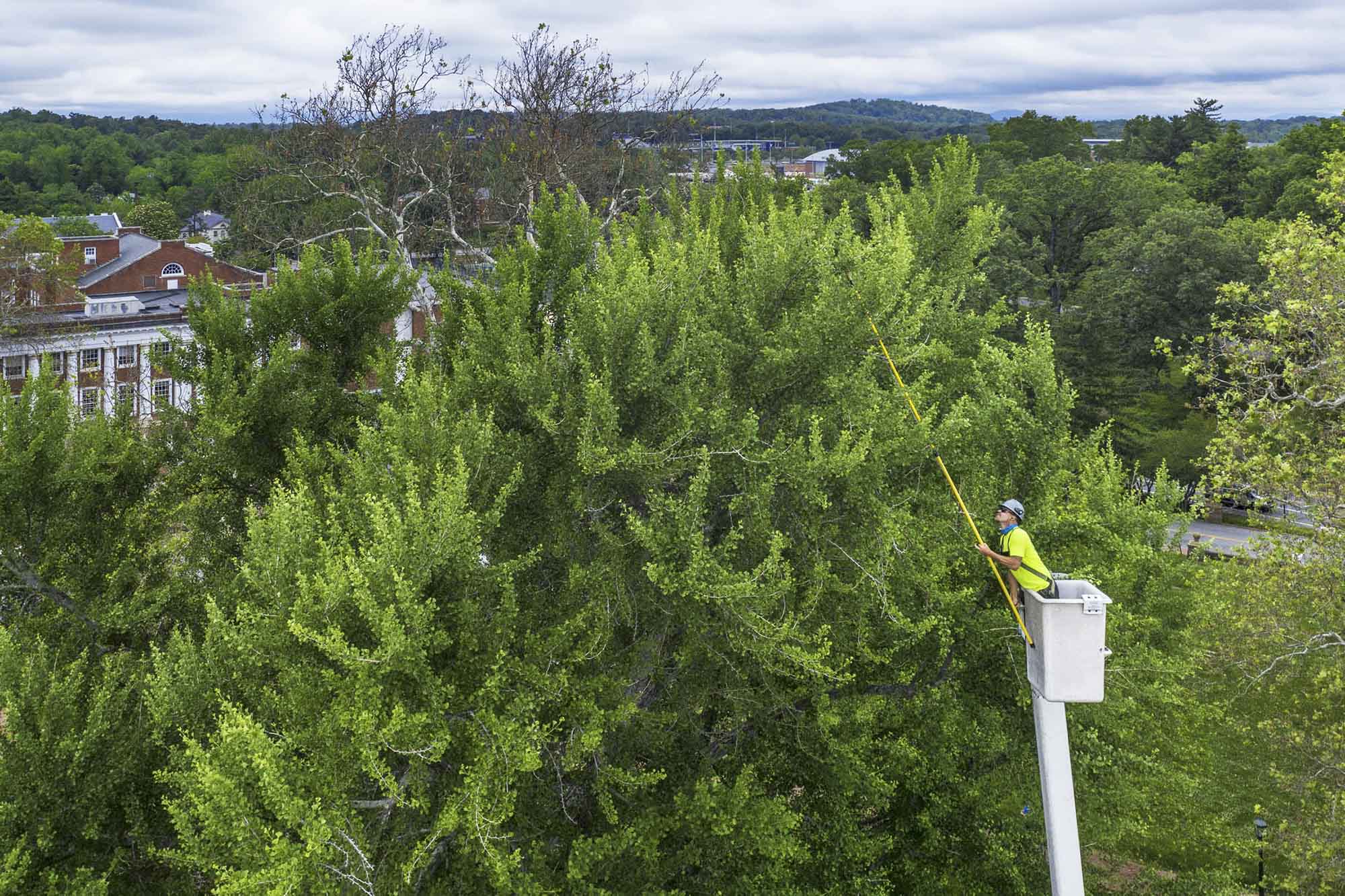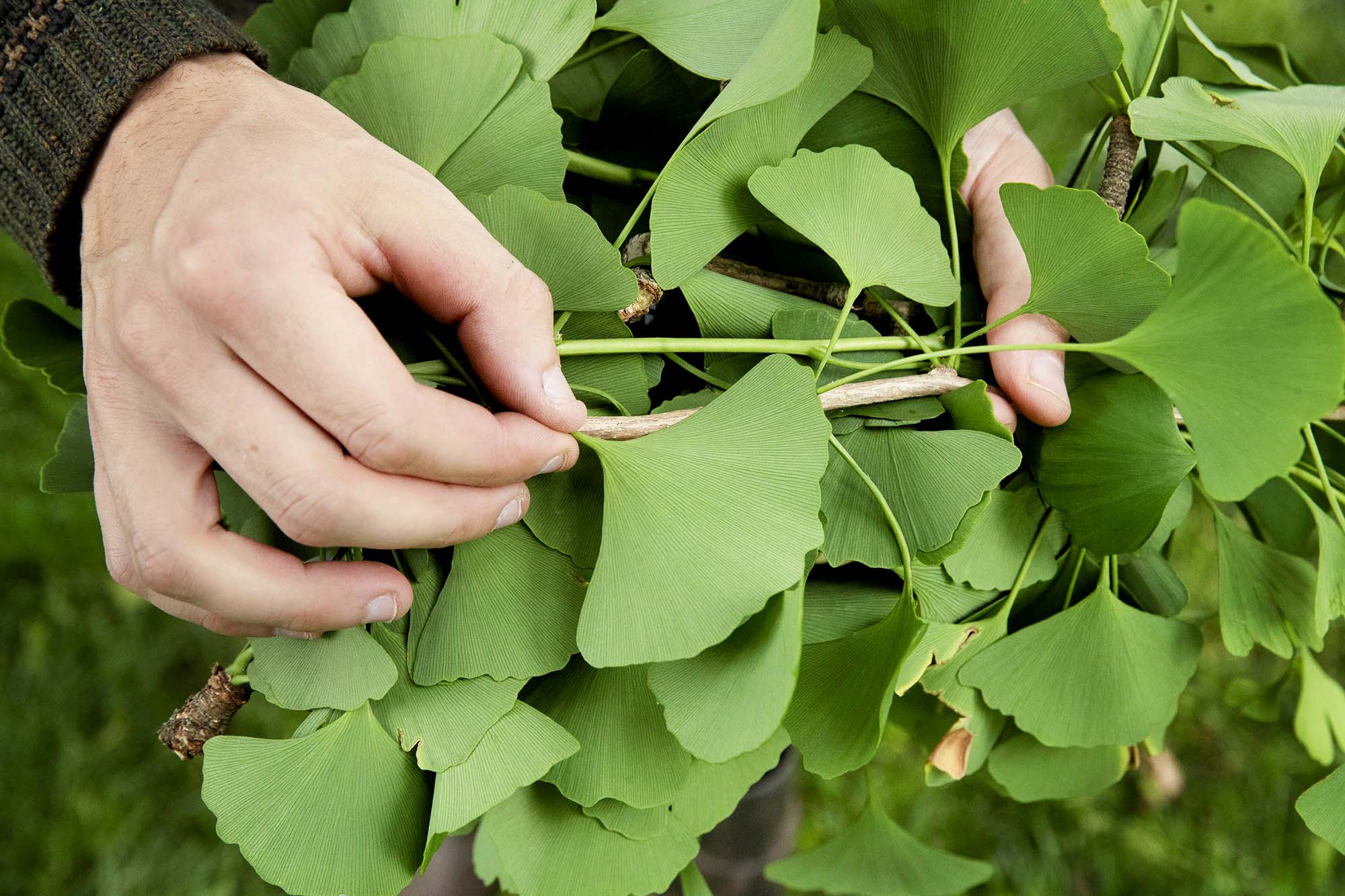In a few years, there may be more ginkgoes on the University of Virginia’s Grounds, continuing a legacy from William A. Pratt.
The Pratt Ginkgo: The Next Generation

Travis Woodson of Big O Tree and Lawn Services trimmed new growth from the University’s 160-year-old Pratt ginkgo tree on Wednesday. (Photo by Sanjay Suchak, University Communications)

“Rooting is the process of forcing portions of plant material to form roots in order to create a genetic clone of the original plant,” Bryars said. “We expedite this process by using a synthetic auxin, the plant hormone responsible for root formation. Auxin acts by forming a callus of undifferentiated cells which then form roots.”
Bryars said that if 50% of the cuttings root and grow into trees, that would be a success. She said they are working with terminal buds from the top of the tree and it should take about two to three years for the new-growth trees to be transplantable.
The new Pratt ginkgoes will be planted alongside Alderman Library once it has been renovated, replacing ginkgoes that are being removed to accommodate the renovation work. When ginkgo trees were first planted alongside Alderman Library, the trees were female and people unwittingly tracked the malodorous fruit into the building on their shoes. Landscapers later removed the female ginkgoes and replaced them with males taken from an earlier rooting of Pratt ginkgo cuttings.
“The collaboration with Monticello came out of the Alderman Library construction project, which requires the removal of the only genetic matches to the Pratt ginkgo we have,” said Richard Hopkins, landscape superintendent at the University’s Division of Facilities Management. “We want to continue the tradition of having ginkgo trees along the side of the library, but we also want to be assured that they will all be male trees to avoid the same issue again with the fruit. The trees don’t fruit for many years after planting, so you don’t know if you have a male or female until the tree has reached a significant size. The Pratt is male, so rooted cuttings guarantee that the trees grown from the cuttings will also all be male.”

To get the potential stock, the cuttings were taken from the new growth on top. Travis Woodson of Big O Tree and Lawn Services raised up into the tree in a truck-mounted, hydraulic-raised bucket and trimmed the new growth from the treetop. Once he had accumulated a bunch of cuttings, he lowered the bucket and handed them to Bryars and Dowell, who marked down the location on the tree from which the cuttings were taken.
This is the first batch of three cuttings from the tree, to be taken at about monthly intervals. These are softwood cuttings and the later cuttings will be harder. Each collection will involve about 100 cuttings.
“This is kind of an experiment,” Bryars said. “We take the different stages of growth, do side-by-side comparisons and we hope for good success rates.”
The tree – named after William A. Pratt, the first superintendent of buildings and grounds – has become an important landmark on Grounds. University landscape architect Mary Hughes views the cuttings as a way of preserving that history.
“The Pratt ginkgo is one of our most historic trees,” Hughes said. “We believe it was planted [by Pratt] in the 1860s and it is certainly a spectacular specimen. The leaves turn gold much later than other ginkgo trees in the area, and then the leaves drop all at once, creating a gold carpet on the ground. It has become one of the rituals of fall and photographers set up days in advance to capture the event. Creating a clone of the tree will allow us to plant a replacement when the inevitable day comes that we lose the parent tree. It is a way of preserving this piece of our landscape heritage.”
Pratt was a well-known Richmond civil engineer who moved to Charlottesville in 1856. He developed a plan for the improvement of the Grounds and spent 1857 through 1859 constructing and renovating many buildings. In 1858, the Board of Visitors named him the University’s first superintendent of buildings and grounds. He is credited with planting many of the older maple and ash trees on the Lawn.

Ginkgo trees are among the world’s oldest species, having been around for about 200 million years, and were among the five dominant species of trees in North America about 150 million years ago. But ginkgoes disappeared from the North American fossil record about 7 million years ago, after a time of climate cooling.
Modern humans found the tree in China and it was mentioned in 800-year-old records of trade between Japan and Korea. The Dutch introduced the tree to continental Europe in 1727, and a botanist named William Hamilton reintroduced the trees to North America in 1784, planting two near Philadelphia.
Both of these trees are now gone; the oldest living ginkgo tree in the U.S. was planted in 1785 or shortly thereafter by the Bartram brothers, also near Philadelphia. Reliable sources say the oldest ginkgoes in the world are around 1,200 years old.
The Pratt ginkgo, about 75 feet tall with a diameter of 59 inches, is healthy, requiring no special treatments. University landscapers have outfitted the tree with a lightning rod that would disperse any electrical strike and save the tree.
The Pratt ginkgo also has a metal horse hitch in its side. Hopkins said the tree has grown around the hitch, a wrought iron ring connected to an anchor bolt. At this point, removing it could create more damage than allowing it to remain.
Media Contacts
University News Associate Office of University Communications
mkelly@virginia.edu (434) 924-7291


